Sacred Geometry: Ireland’s Spirals as Universal Symbols of Harmony

Updated On: April 15, 2024 by Eman Sameh
Sacred geometry is a universal language of truth, beauty, and harmony; it is a visible expression of the invisible fabric of the cosmos. In the emerald heartland of Ireland, this language manifests profoundly through spirals, a motif deeply carved into Celtic culture. Spirals are ubiquitous in Irish art and spirituality, symbolising continuity, growth, and the journey from the material plane to the inner core of being. Ireland’s unique contribution to sacred geometry in the form of these ancient symbols speaks to a larger global narrative where shapes and patterns resonate with collective human consciousness.

Irish spirals found etched into stones of ancient passage tombs and illuminated in manuscripts offer a key to understanding a worldview where all life is interwoven with a cosmic pattern. This embedded symbolism extends beyond Irish shores, reflecting a shared human experience. The presence of similar symbols in various cultures illuminates a profound tapestry of connection and unity, underscoring the fundamental human search for harmony with the cosmos. Our exploration of these symbols is an archaeological pursuit and a spiritual journey, uncovering how the echoes of ancient wisdom found in sacred geometry still reverberate in our modern world.
Historical Context of Irish Spirals
Before we delve into the specifics, it’s essential to understand that the story of Irish spirals intertwines with Ireland’s ancient history and cultural evolution, from the Neolithic era to Celtic and early Christian influences.
Neolithic Era and Newgrange
During the Neolithic period, around 3200 BC, remarkable megalithic structures like Newgrange in the Boyne Valley were constructed. These passage tombs are famous for their intricate spiral designs and hold great archaeological significance. Newgrange, one of the most famous Neolithic burial tombs, is adorned with these captivating patterns, showcasing the sophisticated artistry of the Neolithic people.
Celtic and Early Christian Influences
As we transition into the realm of the Celts, the spiral symbolises harmony and continuity. Celtic culture embraced the spiral motif, adapting it into their metalwork, stonework, and illuminated manuscripts. This motif can commonly be seen in the form of the Celtic cross, where the spiral design merges with Christian symbolism to create a unique cultural synthesis. These symbols testify to the intertwining of pagan and Christian traditions in early Irish history.
Symbolism in Irish Spirals
As we explore the sacred geometry of Ireland’s spirals, we grasp these motifs’ profound cultural and spiritual resonance within the Celtic tradition.
The Spirals and Their Meanings
Irish spirals, epitomised by the ancient symbol of the spiral triskele, carry many meanings deeply rooted in our Celtic heritage. Celtic spirals, often witnessed at historical sites like Newgrange, symbolise the eternal rhythm of life – birth, death, and rebirth – and the passage of time and seasons. Each turn in the spiral signifies a significant life milestone or a period of growth and evolution. The triple spiral, or triskele, is particularly significant and is found across Celtic art, symbolising concepts such as the trinity of life: land, sea, and sky or the past, present, and future.
The Celtic Knots and Their Significance
Celtic knots, including the Celtic spiral knot, convey the interconnectedness of all life. These continuous loops represent the inextricable link between physical and spiritual paths, with no beginning or end. The Celtic symbol for strength, sometimes depicted within these knots, embodies the resilience and the fortitude to overcome life’s trials. Certain knots also symbolise protection, unity, and the unbroken life cycle, reinforcing the belief that life and eternity are endlessly entwined.
Celestial and Natural Influences
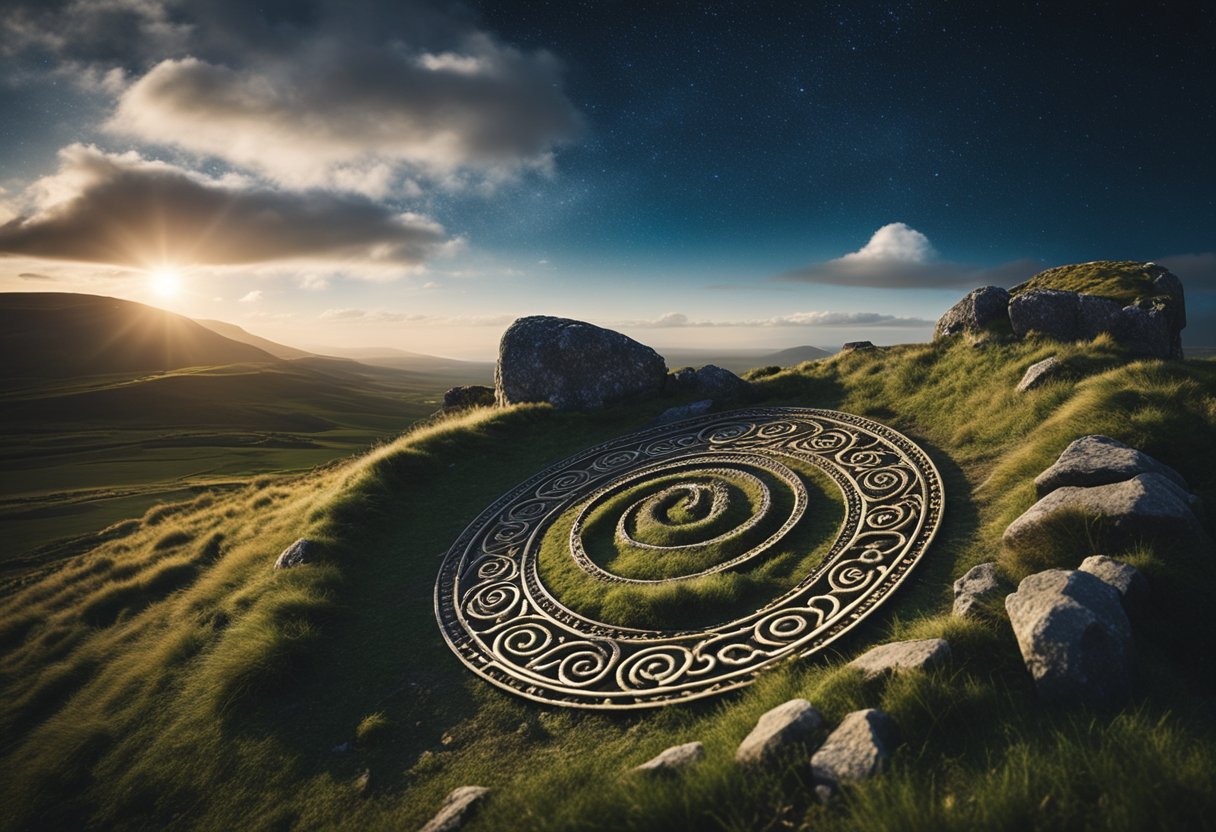
As we explore the fabric of the cosmos and the Earth’s rhythms, we recognise celestial and natural patterns’ profound impact on sacred geometry. Our ancestors observed these patterns and embedded them into their spiritual and architectural practices.
Solar Alignments and the Winter Solstice
The winter solstice is a pivotal astronomical event where the sun reaches its lowest altitude in the sky. This occurrence has influenced numerous sacred sites across Ireland, such as Newgrange, where the chamber is famously illuminated by the solstice sunrise. This interplay between sun and earth during the solstice is a powerful reminder of the sun’s significance in celestial cycles and its role in the harmony of sacred geometrical designs.
Natural Elements and Sacred Symbols
Sacred geometry is also deeply intertwined with natural elements like water and sky. Spirals reminiscent of the Fibonacci sequence, which manifests in water vortexes or the sprawling arms of galaxies, are common motifs in Irish art and culture. These symbols echo the intrinsic order found across natural elements, reflecting a universal reverence for the connectedness of all life, from the branching of trees to the flowing patterns of rivers.
Incorporation into Celtic Life and Tradition
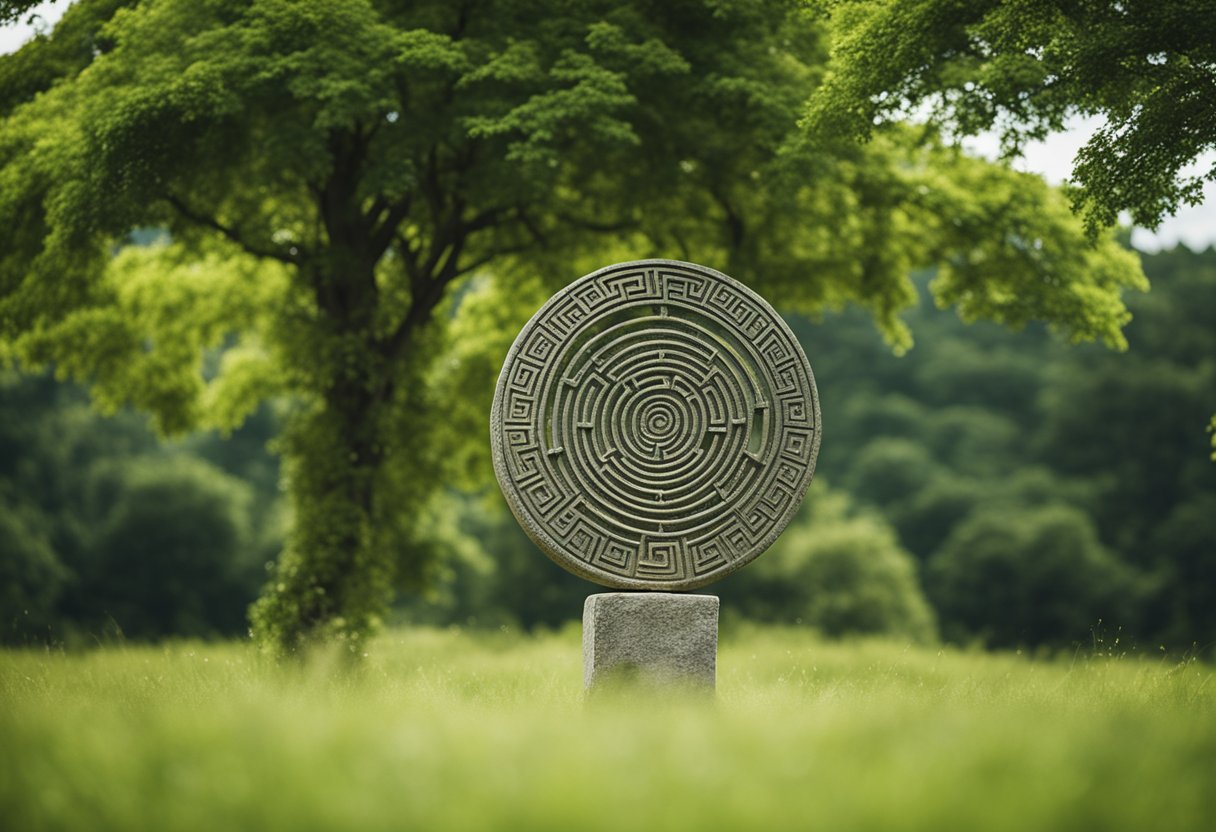
As we explore the depth of sacred geometry within the Celtic tradition, it’s crucial to understand its profound integration into the fabric of ancient Irish life, influencing their sacred sites and the artefacts they held dear.
Sacred Sites and Structures
Sacred geometry can be seen woven into the layouts of ancient Celtic sites across Ireland, where spiritual significance and natural harmony converged. The Celtic Tree of Life serves as a prime example, representing a connection between the heavens and the earth, a motif that often appeared in the designs of their sacred groves and sanctuaries. Ireland’s landscape is dotted with such spiritual places, where spirals and geometric designs are etched into stone, merging local reverence with universal harmony.
Ceremonial Artefacts and Jewellery
Equally, Celtic jewellery often features complex knotwork and spirals derived from their profound respect for the natural world and its cycles. The craftsmanship of items such as torches and brooches was not only about adornment but also encapsulated a rich tapestry of meanings and beliefs. The mingling of Celtic tradition with art is evident in artefacts like the famous Tara Brooch, which acknowledges both the aesthetic appeal and symbolic depth favoured by the Celts.
Celtic Mythology and Spirituality
In exploring Celtic mythology and spirituality, we uncover a profound connection to nature and the cosmos, deeply intertwined with the ritualistic practices of ancient peoples and the serene symbolism that has since been adapted into Christian motifs.
The Druids and Pagan Practices
The Druids were esteemed as wise elders within Celtic societies, often serving as priests, teachers, and judges. Their spirituality was firmly rooted in the land, with a strong belief in the sacredness of all places. Paganism, embodying polytheistic traditions, was central to their beliefs and practices. Spirits, gods, and mythical beings populated their world, each linked to natural elements such as water, trees, and the sun.
Pagan symbols, like the Triple Goddess, representing the phases of the moon and aspects of womanhood exemplified the Celts’ spirituality. We also witness the enduring legacy of these symbols, such as the Celtic Knot, which transcends time and belief systems to convey the eternal nature of the spirit and life.
Adaptation to Christian Symbolism
As Christianity spread through the Celtic lands, preexisting pagan symbols and practices were often interwoven with Christian symbolism to create a unique blend of spiritual beliefs. The Celtic Cross, with its distinctive circle intersecting the vertical and horizontal arms, perfectly illustrates this synthesis. It is a Christian symbol of faith and reflects the Celtic adoration for the sun, a source of life and energy.
Similarly, spirals, which hold significant meaning in Celtic mythology as emblems of harmony and the universe’s interconnectedness, found their way into Christian artwork, symbolising the Holy Trinity. This adaptation illustrates the harmonious blending of pagan and Christian motifs fostered by mutual respect and spiritual synchronicity.
Contemporary Manifestations
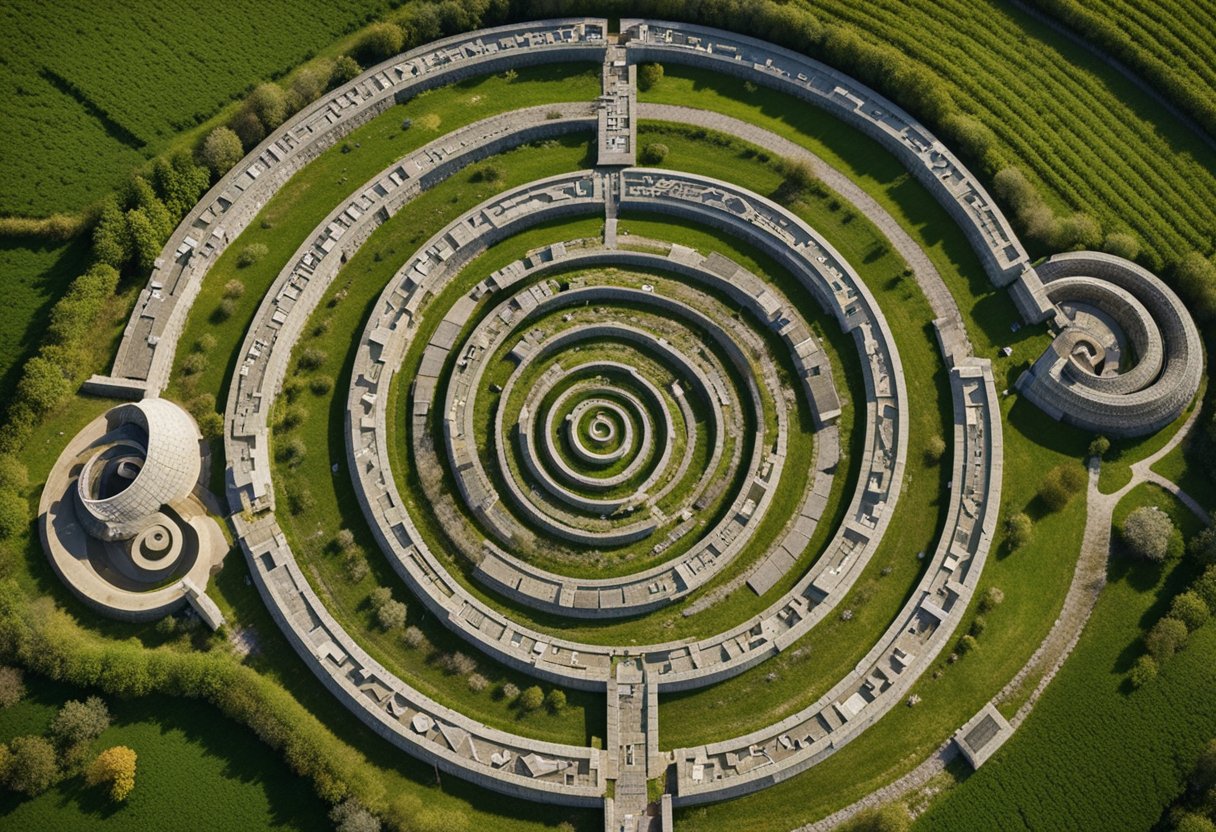
Sacred geometry continues to resonate through time, finding its place in the contemporary world through cultural resurgences and artistic expressions that echo ancient traditions.
Celtic Revival and Modern Usage
The Celtic Revival of the 19th and 20th centuries rekindled interest in Irish symbols, entwining them within the fabric of modern culture and identity. This resurgence has led to a blossoming appreciation for the intertwining spirals and complex knotwork that characterise Celtic art. Such motifs inaugurate public spaces, adorn ceremonial garb, and inspire architectural designs that pay homage to our Irish heritage while propelling it into contemporary relevance.
Symbols in Popular Culture and Tattoos
In popular culture, the eternal spirals and Celtic symbols inject a sense of ancient harmony into modern aesthetics. Tattoos, for example, often feature this sacred art; each line and curve is a testament to personal growth or a connection to Irish ancestry. These symbols have transcended the realm of the symbols of Ireland, becoming popular symbols in a myriad of cultural expressions worldwide. From music albums to film iconography, these sacred symbols are woven seamlessly into the global tapestry, signifying a universal language of balance and continuity.
The Triskelion and Related Symbols
The Triskelion is a motif with a rich history and diverse meanings. It is entwined with the concept of triplicity, which we see reflected in various global symbols of harmony.
Triple Spiral and Triquetra
The Triple Spiral, or Triskele, is a prominent symbol in Irish culture, denoting various trinities such as life, death, and rebirth. As seen in the pre-Celtic site of Newgrange, the triple spiral predates even Celtic symbolism and reflects the power of three, an echoing theme found at Ireland Travel Guides.
Another Celtic symbol, the Triquetra, or Trinity Knot, comprises three interconnected arcs that signify concepts such as mind, body, and spirit. Though distinct, the Triquetra and the Triple Spiral share the common theme of triplicity and are sometimes used interchangeably within Celtic art and symbolism. The intertwining nature of these knots and spirals embodies unity and an eternal spiritual continuum.
Global Symbols of Harmony
The Triskelion, and by extension, the Triple Spiral, goes beyond Irish culture, echoing various global symbols of harmony. A notable example is the “three legs” of the Isle of Man’s flag, which is representative of the Triskelion. This depicts the island’s independence and resilience.
The principle of triplicity also extends to other cultures, represented, for instance, in the Buddhist “Gankyil,” symbolising the harmony of the three jewels: Buddha, Dharma, and Sangha. Such motifs are prevalent worldwide, embodying the universal resonance of balance and perpetual motion. More on the Triskelion’s global significance can be uncovered at Connolly Cove, illuminating how themes of triplicity and harmony are fundamental to the human experience across cultures and epochs.
Geometrical Analysis and Interpretation
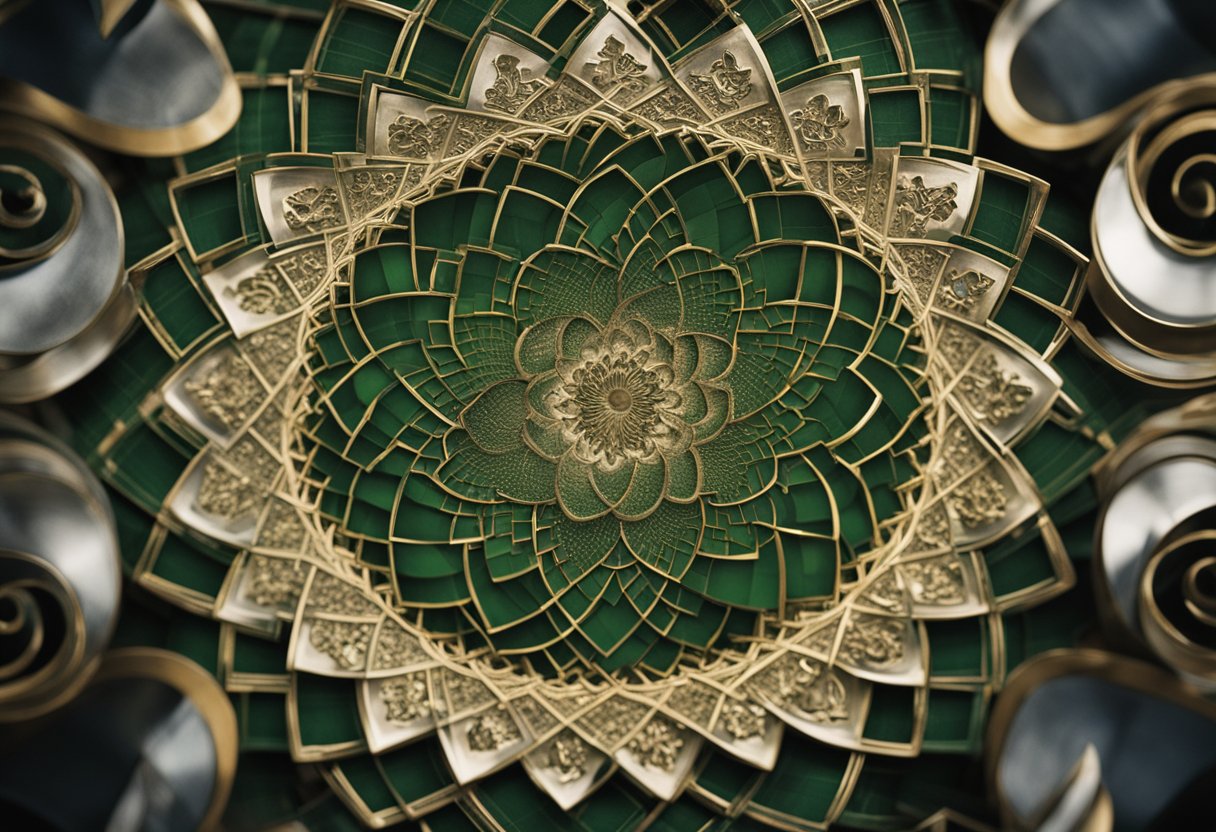
Before delving into the intricacies of sacred geometry, it is crucial to understand how spirals embody mathematical precision and profoundly express geometrical principles in art and symbols.
Mathematical Precision in Spirals
Spirals are a captivating example of the synchronicity between geometry and the natural world. They are a physical manifestation of the Fibonacci sequence, representing progress and continuity in a harmonious pattern that can be mathematically quantified. The ratio within these spirals is often called the Golden Ratio, which quite literally calculates the beauty of nature’s design.
Our analysis shows that spirals are aesthetically pleasing and embody a mathematical precision that resonates with strength and energy. They can be observed in the shells along the Irish coastline, suggesting a deep connection to motion and life’s intrinsic propensity to move and grow in accordance with sacred geometric patterns.
Geometry in Art and Symbols
Geometry is deeply embedded in the art and symbols we encounter, serving as a visual language that transcends cultural boundaries. For instance, we see spirals in Irish megalithic art, which offer rich visual tales of ancient wisdom and a calendrical understanding of the universe. This could be interpreted as decoding the movement of celestial bodies, reflecting a sophisticated understanding of the cosmos.
Moreover, these symbols, found globally, from the stony engravings of Newgrange in Ireland to the intricate designs of East Asian mandalas, are steeped in symbolic meaning. They are a testament to the human quest for understanding and energy beyond the visible realm, encapsulating our enduring quest to create order and harmony within the world around us.
Preservation and Education
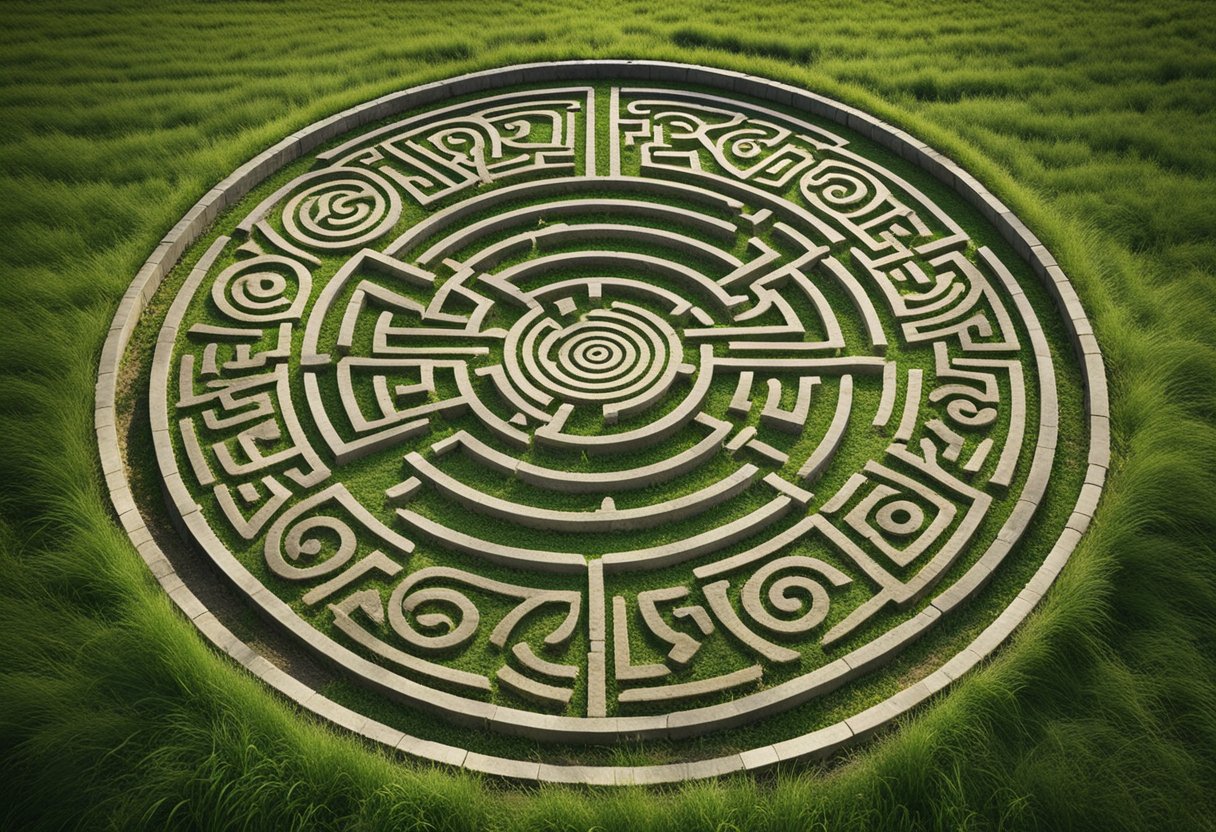
In this section, we explore the crucial roles that museums, educational institutions, the Irish State, and various organisations play in preserving and disseminating knowledge about sacred geometry and Ireland’s spirals, ensuring these symbols of wisdom and longevity are passed down through generations.
Museums and Educational Institutions
Educational institutions and museums are fundamental in safeguarding and sharing the intricate tapestry of sacred geometry. They curate exhibits that weave the story of these ancient symbols, connecting them to a global context of harmony and balance. For instance, museums may house collections of Celtic spirals, often found in Irish artefacts, providing insights into their significance and relevance in contemporary society. These institutions provide platforms for lifelong learning and foster a deeper appreciation among both locals and visitors.
Key Entities
- Exhibits: Showcasing sacred geometry and spirals.
- Workshops: Educating on the art and mathematics behind the patterns.
- Lectures: Experts share knowledge on cultural significance and applications.
Role of the Irish State and Organisations
The Irish State plays a pivotal role in preserving sacred geometric patterns, particularly the renowned spirals of Ireland. This responsibility extends to entities such as the Irish Air Corps, which contributes to safeguarding Ireland’s rich heritage from above. Additionally, organisations embody the spirit of longevity through the preservation of these timeless symbols. Their efforts are often multifaceted, ranging from physical conservation projects to promoting awareness and understanding of the cultural significance of these patterns.
Key Initiatives
- Preservation Projects: Restoring and maintaining historical sites.
- Cultural Programmes: Engaging the public in Ireland’s rich heritage.
- Collaboration: Working with entities like Connolly Cove to promote Irish culture globally.
Symbols of Connection and Unity
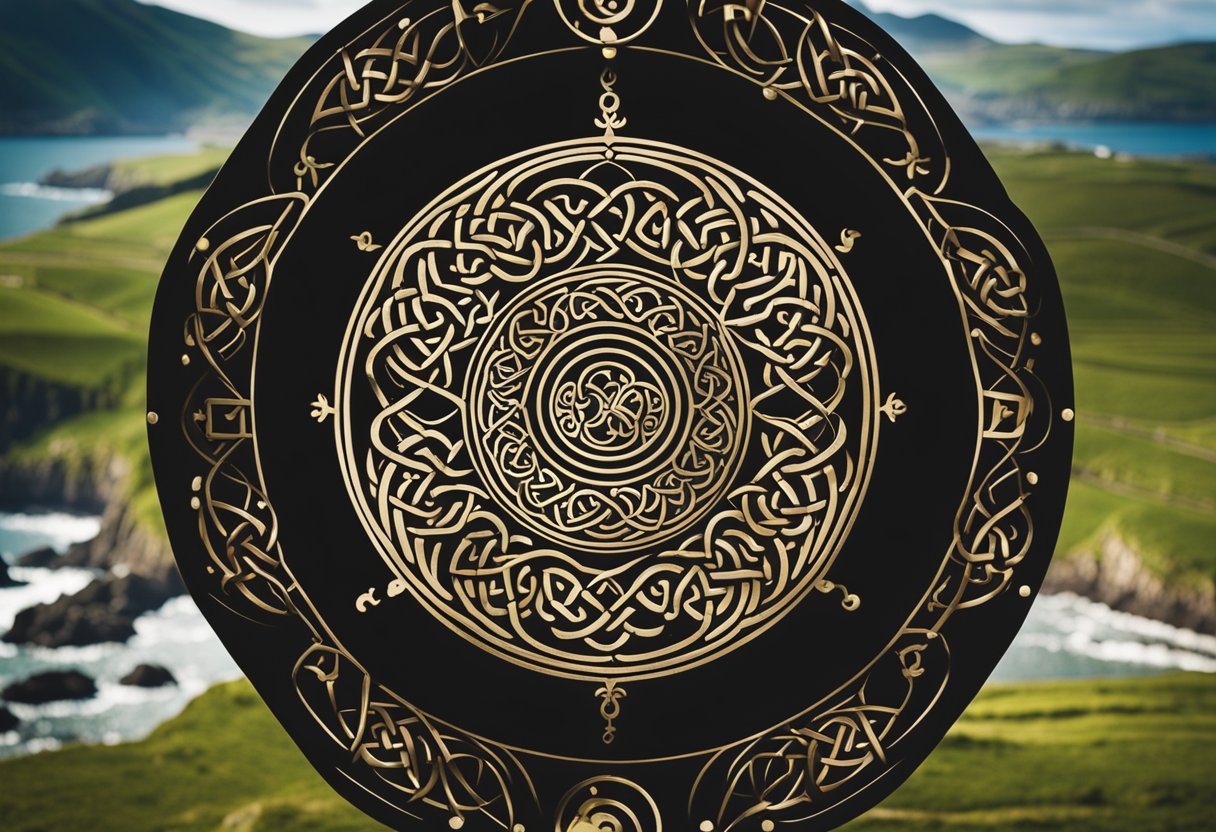
In our exploration of Sacred Geometry, we find that symbols across various cultures convey profound connections and unity in the tapestry of life. These symbols, etched into artefacts and architecture, represent the seamless ties and transitions between stages of existence.
Interconnectedness of Life’s Cycles
One emblematic representation of the interconnectedness of life’s cycles is the spiral, traced back to Neolithic times in Ireland. These ancient spirals, located at sites such as Newgrange, stand not only as a form of Celtic art but also as a testament to the continuity of life, encompassing past, present, and future cycles in their unending curves. As we trace each coil, we can see the unity of temporal experiences, with each turn encapsulating a moment within the eternal flow.
Symbols of Life, Death, and Rebirth
Accompanying the spiral is the ubiquitous symbol of the triquetra, embodying the themes of life, death, and rebirth. This intricate Celtic symbol intertwines to form a unity without beginning or end. It represents the inseparability of the three worlds: the physical realm, the spiritual sphere, and the celestial domain. In its unity of the triad, it deeply resonates with the concept of life-death-rebirth cycles. Throughout Sacred Geometry, these symbols offer comfort and understanding through their harmonious balance and continuity, reminding us that life, in its essence, is a journey of interconnected and perpetual transformations.
Influence Beyond Ireland
In elucidating Sacred Geometry’s influence, one cannot overlook its profound impact beyond the borders of Ireland, reaching deep into Euro-American culture and gaining global recognition.
Symbols in Euro-American Culture
In Euro-American culture, spirals have manifested in various forms, from the intricate triskelions on the flag of Sicily to the fascinating designs featured on coins of the common euro currency. Each integration honours the visual appeal of these ancient patterns and their symbolic significance of growth, evolution, and connectivity.
- Flag of Sicily: Its emblem embodies the triskelion, with three bent human legs intertwined with the head of the Gorgon, encapsulating protection and history.
- Euro Currency: Coins like the 2-euro depict stylised swirls, echoing the spiral motifs dating back to the Irish Bronze Age, signifying unity amidst diversity in modern Europe.
Global Recognition and Adoption
The influence of spirals extends worldwide in both conscious adoption and subliminal presence. Malta preserves its history with spiral designs at the Ħal Saflieni Hypogeum, reflecting a shared reverence for these forms stretching across cultures and time periods. Over in the United States, we see spirals in Native American petroglyphs signifying a similar philosophical understanding as the ancient Irish.
- Ħal Saflieni Hypogeum, Malta: This UNESCO World Heritage site features a labyrinth of underground chambers, where spiral motifs on the walls stand as a testament to universal patterns of spirituality.
- Isle of Man: The three-legged triskelion, known as the ‘Three Legs of Man,’ is a national symbol that adorns the flag, signifying perseverance and endurance.
Emblematic of life’s cyclic nature and cosmic harmony, these symbols amplify our intrinsic connection regardless of geographic or cultural disparities.
Frequently Asked Questions

Sacred geometry encompasses a wealth of symbolism and meaning, often seen as a bridge between the physical and spiritual worlds. It generates curiosity, and we aim to address some of the most common inquiries.
What are the interpretations of different sacred geometry symbols?
Symbols in sacred geometry carry various meanings, from the flower of life signifying creation and interconnectedness to the Vesica Piscis representing duality and balance.
How is sacred geometry thought to influence manifestation processes?
Adherents believe that sacred geometry can harness cosmic vibrations, thereby aiding in actualising one’s intentions into physical realities.
In what ways are sacred geometry symbols believed to attract wealth?
Certain shapes in sacred geometry, like the Shri Yantra, are thought to channel abundance by aligning with the energy patterns of creation and prosperity.
What is the significance of sacred geometry patterns in healing?
Patterns such as the Seed of Life are used in healing practices to recalibrate the body’s energy fields, promoting balance and well-being.
How does sacred geometry appear in the natural world?
From the Fibonacci sequence seen in pine cones to the hexagonal shapes of a honeycomb, nature’s designs often follow principles of sacred geometry.
What is the meaning attributed to the spiral shape within sacred geometry?
The spiral, especially the Celtic spiral, represents a journey from external consciousness to the inner soul, signifying growth and cosmic energy.






